One of the most powerful tools in my marketing toolkit is the concept of brand archetypes. If you’ve ever wondered why some brands stick in your mind while others fade into the background, the answer often lies in how well they embody their brand archetype. But what exactly are brand archetypes, and why are they so crucial for building a memorable brand? Let’s dive in!
What Are Brand Archetypes?
Brand archetypes are universal characters or personas that tap into human psychology and evoke emotional responses. These archetypes, identified by psychologist Carl Jung, help create a relatable and consistent brand identity that resonates with your audience on a deeper level. By aligning your brand with a specific archetype, you can craft a compelling narrative and a strong emotional connection with your customers.

Why Are Brand Archetypes Important?
1. Consistency and Clarity: Archetypes provide a clear and consistent framework for your brand’s voice, tone, and messaging. This consistency builds trust and loyalty among your audience.
2. Emotional Connection: Humans are hardwired to respond to stories and characters. When your brand embodies a recognizable archetype, it taps into familiar patterns, making it easier for people to relate to and remember your brand.
3. Differentiation: In a crowded marketplace, standing out is essential. Archetypes help differentiate your brand by giving it a unique personality that sets it apart from competitors.
The 12 Brand Archetypes
1. The Innocent
- Description: Pure, optimistic, and morally good.
- Goal: To be happy and bring happiness to others.
- Example: Dove. With its focus on natural beauty and self-care, Dove embodies the Innocent archetype by promoting simplicity and purity.
2. The Everyman
- Description: Approachable, friendly, and empathetic.
- Goal: To belong and connect with others.
- Example: IKEA. Known for its affordable and accessible furniture, IKEA resonates with the Everyman archetype by being relatable and practical.
3. The Hero
- Description: Courageous, determined, and inspirational.
- Goal: To improve the world and prove worth through courageous acts.
- Example: Nike. With its “Just Do It” mantra, Nike inspires individuals to overcome challenges and achieve greatness, embodying the Hero archetype.
4. The Outlaw
- Description: Rebellious, disruptive, and unconventional.
- Goal: To challenge the status quo and create change.
- Example: Harley-Davidson. Known for its rebellious spirit, Harley-Davidson attracts those who live life on their own terms.
5. The Explorer
- Description: Adventurous, independent, and curious.
- Goal: To experience a fulfilling and authentic life.
- Example: REI. With a focus on outdoor gear and adventures, REI embodies the Explorer archetype by encouraging exploration and discovery.
6. The Creator
- Description: Imaginative, innovative, and artistic.
- Goal: To create something of enduring value.
- Example: LEGO. Encouraging creativity and imagination, LEGO inspires individuals to build and create, perfectly aligning with the Creator archetype.
7. The Ruler
- Description: Authoritative, responsible, and organized.
- Goal: To create order and control.
- Example: Rolex. Synonymous with luxury and precision, Rolex embodies the Ruler archetype with its high standards and meticulous craftsmanship.
8. The Magician
- Description: Visionary, charismatic, and transformative.
- Goal: To make dreams come true and create something special.
- Example: Disney. Known for its magical experiences and storytelling, Disney perfectly captures the essence of the Magician archetype.
9. The Lover
- Description: Passionate, sensual, and committed.
- Goal: To create intimacy and build relationships.
- Example: Chanel. With its focus on luxury, beauty, and romance, Chanel embodies the Lover archetype, evoking passion and desire.
10. The Caregiver
- Description: Compassionate, nurturing, and supportive.
- Goal: To help others and provide care.
- Example: Johnson & Johnson. Focused on healthcare and well-being, Johnson & Johnson is the epitome of the Caregiver archetype.
11. The Jester
- Description: Fun-loving, playful, and humorous.
- Goal: To bring joy and lighten up the world.
- Example: Old Spice. With its humorous and quirky advertisements, Old Spice effectively captures the Jester archetype.
12. The Sage
- Description: Wise, knowledgeable, and reflective.
- Goal: To seek truth and share wisdom.
- Example: Google. As a vast repository of information and knowledge, Google embodies the Sage archetype, guiding users to the answers they seek.
How to Use Brand Archetypes
To effectively use brand archetypes, follow these steps:
1. Identify Your Archetype: Determine which archetype best aligns with your brand’s values, mission, and personality.
2. Define Your Brand Story: Craft a narrative that reflects your chosen archetype, ensuring it resonates with your target audience.
3. Maintain Consistency: Consistently apply your archetype across all brand touchpoints, from marketing materials to customer interactions.
4. Evolve as Needed: As your brand grows, don’t be afraid to evolve your archetype while staying true to your core values.
Conclusion
Embracing a brand archetype can transform your brand from forgettable to unforgettable. By understanding and leveraging these universal characters, you can create a strong, emotionally resonant brand that stands the test of time. Whether you’re a daring Outlaw, a nurturing Caregiver, or a visionary Magician, there’s an archetype that’s perfect for your brand.
Ready to discover your brand’s true identity? Let’s explore how we can unlock the power of brand archetypes to ignite growth and impact for your business. Reach out today, and let’s start your journey towards a memorable brand.

—
Ian Gattie is a seasoned strategic marketing and creative professional with over 15 years of hands-on experience in devising and implementing data-driven marketing and communication programs. As a change agent, Ian has demonstrated a remarkable track record in assembling and mentoring teams that consistently surpass organizational objectives. Currently based in Buffalo, NY, Ian’s expertise spans across a diverse range of industries, encompassing cybersecurity, IT, education, non-profit, construction, professional services, startups, and other small businesses.
